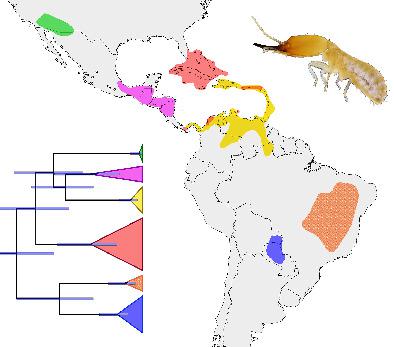当前位置:
X-MOL 学术
›
Syst. Entomol.
›
论文详情
Our official English website, www.x-mol.net, welcomes your feedback! (Note: you will need to create a separate account there.)
New World Heterotermes (Isoptera, Rhinotermitidae): molecular phylogeny, biogeography and description of a new species
Systematic Entomology ( IF 4.8 ) Pub Date : 2020-06-02 , DOI: 10.1111/syen.12412 Tiago F. Carrijo 1 , Matheus Pontes‐Nogueira 1 , Rafaella G. Santos 2, 3 , Adriana C. Morales 4 , Eliana M. Cancello 2 , Rudolf H. Scheffrahn 5
Systematic Entomology ( IF 4.8 ) Pub Date : 2020-06-02 , DOI: 10.1111/syen.12412 Tiago F. Carrijo 1 , Matheus Pontes‐Nogueira 1 , Rafaella G. Santos 2, 3 , Adriana C. Morales 4 , Eliana M. Cancello 2 , Rudolf H. Scheffrahn 5
Affiliation

|
Heterotermes Froggatt is a subterranean termite genus consisting of 30 living described species worldwide, with nine occurring in the New World. Herein we provide a molecular phylogeny, using both mitochondrial and nuclear markers, of all New World species of Heterotermes, including biogeographical analysis, and describe a new species from Paraguay and Bolivia, based on morphological and molecular evidence. Our analysis recovered the New World species as paraphyletic to a monophyletic Australian clade. Within this New World + Australian clade, two monophyletic major groups were formed c. 28 Ma: the aureus‐ and tenuis‐groups. The aureus‐group has a disjunct and broad distribution consisting of two clades. The first clade extends into the Nearctic region and a second is composed of a branch in the Caatinga and Cerrado biomes (H. sulcatus Mathews) and a branch in the Chacoan biome (a new species, Heterotermes lauralinearum Carrijo sp.n.). The tenuis‐group is composed of four broadly distributed Neotropical species and the Australian clade. A single dispersion event from South America to Australia probably occurred between 13 and 24 Ma. Heterotermes crinitus Emerson was the first to diverge, being sister group of all other species in the tenuis‐group, followed by Heterotermes assu Constantino. An analysis of the historical biogeography of Heterotermes suggests that jump dispersal was the most important cladogenetic process for the genus. This study is the most comprehensive phylogeny of Heterotermes and contributes to the understanding of termite evolution and geographic distribution in the New World, complementing recent studies focused on worldwide patterns.
中文翻译:

新世界异白蚁(等翅目、鼻白蚁科):新物种的分子系统发育、生物地理学和描述
Heterotermes Froggatt 是一种地下白蚁属,由全世界 30 种已描述的现存物种组成,其中 9 种出现在新世界。在此,我们使用线粒体和核标记提供了所有异白蚁新世界物种的分子系统发育,包括生物地理分析,并根据形态学和分子证据描述了来自巴拉圭和玻利维亚的新物种。我们的分析将新世界物种恢复为单系澳大利亚进化枝的并系群。在这个新世界 + 澳大利亚分支中,形成了两个单系主要群体 c。28 Ma:aureus-和tenuis-groups。金黄色葡萄球菌群有一个由两个进化枝组成的分离和广泛的分布。第一个分支延伸到近北区,第二个分支由卡廷加和塞拉多生物群落中的一个分支组成(H. sulcatus Mathews) 和 Chacoan 生物群落中的一个分支(一个新物种,Heterotermes lauralinearum Carrijo sp.n.)。特努伊斯群由四个广泛分布的新热带物种和澳大利亚进化枝组成。从南美洲到澳大利亚的一次分散事件可能发生在 13 到 24 Ma 之间。Heterotermes crinitus Emerson 是第一个分化的,是特努伊斯群中所有其他物种的姐妹群,其次是 Heterotermes assu Constantino。对异白蚁历史生物地理学的分析表明,跳跃扩散是该属最重要的进化枝发生过程。这项研究是异白蚁最全面的系统发育研究,有助于了解白蚁在新世界的进化和地理分布,补充了最近关注全球模式的研究。
更新日期:2020-06-02
中文翻译:

新世界异白蚁(等翅目、鼻白蚁科):新物种的分子系统发育、生物地理学和描述
Heterotermes Froggatt 是一种地下白蚁属,由全世界 30 种已描述的现存物种组成,其中 9 种出现在新世界。在此,我们使用线粒体和核标记提供了所有异白蚁新世界物种的分子系统发育,包括生物地理分析,并根据形态学和分子证据描述了来自巴拉圭和玻利维亚的新物种。我们的分析将新世界物种恢复为单系澳大利亚进化枝的并系群。在这个新世界 + 澳大利亚分支中,形成了两个单系主要群体 c。28 Ma:aureus-和tenuis-groups。金黄色葡萄球菌群有一个由两个进化枝组成的分离和广泛的分布。第一个分支延伸到近北区,第二个分支由卡廷加和塞拉多生物群落中的一个分支组成(H. sulcatus Mathews) 和 Chacoan 生物群落中的一个分支(一个新物种,Heterotermes lauralinearum Carrijo sp.n.)。特努伊斯群由四个广泛分布的新热带物种和澳大利亚进化枝组成。从南美洲到澳大利亚的一次分散事件可能发生在 13 到 24 Ma 之间。Heterotermes crinitus Emerson 是第一个分化的,是特努伊斯群中所有其他物种的姐妹群,其次是 Heterotermes assu Constantino。对异白蚁历史生物地理学的分析表明,跳跃扩散是该属最重要的进化枝发生过程。这项研究是异白蚁最全面的系统发育研究,有助于了解白蚁在新世界的进化和地理分布,补充了最近关注全球模式的研究。



























 京公网安备 11010802027423号
京公网安备 11010802027423号